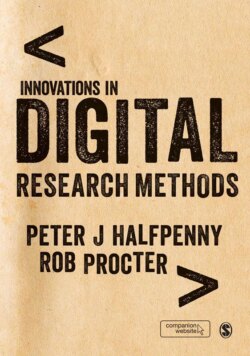Читать книгу Innovations in Digital Research Methods - Группа авторов - Страница 26
На сайте Литреса книга снята с продажи.
Chapter 11: Visualizing Spatial Data and Social Media
ОглавлениеAs earlier chapters have emphasized, the social data landscape is changing at an ever-increasing pace. The ways in which data is visualized has always played an important role in its analysis and in the presentation of results, and the ever-increasing volumes of data raise new challenges for visualization methods and tools. In this chapter, following a brief history of geographic information systems (GIS), Batty and his colleagues describe new ways of visualizing social data, with a particular emphasis on mapping. They argue that Web 2.0 mash-ups, layering geographically tagged social data on top of digital maps, enable quick and simple visualization of data, presenting research outcomes in ways that can be easily understood by diverse audiences.
Many of the examples the authors present emphasize how much researchers can achieve using simple, generic technologies and services such as Google Maps and Fusion Tables. Helpfully, Batty and his colleagues at UCL’s Centre for Advanced Spatial Analysis (CASA) have packaged these services into useful tools (such as MapTube5), which not only enable the geo-mapping of datasets with a few button clicks, but also provide ways for researchers to share and re-use each other’s efforts.
Another way in which advances in visualization techniques have harnessed the increase in computer power and new sources of data is the creation of fly-through, 3D models and visualizations of, for example, urban environments. More mundanely, but perhaps of greater value to researchers and planners involved in urban science, and the latest of many research areas predicted to be transformed by the advent of big data,6 are CASA’s ‘city dashboards’, which integrate diverse sources of data to create a real-time visualization of the state of the city and its inhabitants. Example applications include visualizing in real-time the state of mass transit systems. Such tools can provide powerful and intuitive front-ends to the simulations and models presented in Chapter 6, allowing, for example, exploration of the impact of closure of parts of the system.
Batty and his co-authors stress the importance of crowdsourcing and ‘citizen science’ for creating resources accessible to the public and illustrate this with the example of Open Street Map, a free map of the world.7 They conclude with some thoughts on the future of visualization as a tool for social scientific investigation and understanding. They predict the emergence of radically different kinds of tools that make use of more abstract forms of visualization, with an increasing emphasis on the use of non-spatial data as the way forward for understanding how social systems function.
